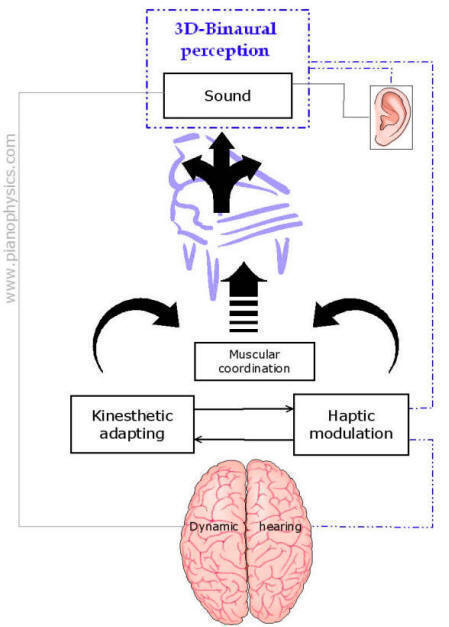There is no a general assent about what musical aura really is, the excerption probably derived out from the need to call in some way a substantial lacking in electronic digital synthesis of undampered pedal strings resonances of piano.
Perceptive aural capability: what are the biological limits of aural perception in humans? are humans the only species to have harmonic perception?
There are many questions concerning aural perception:
- when does background sound, noise, and music go into the background? when is it in the foreground?
- when do two sounds have binaural interest? three sounds... trinaural, four sounds... etc.?
- at what point does the quantity of sound sources attain perceptual conglomeration?
- how does harmonic interest encourage multiple sound source recognition?
- how is the aural attention span affected by different sound sources?
moreover, how does soloist audio affect attentive aural perception versus ensembles audio? how does a static sound source affect attentive aural perception duration? what is the average attentive aural perception duration? ... these are too many questions without an answer.

Reproduce the real sympathetic vibration of acoustic piano strings is one of the most difficult things to achieve in electronic pianos sound emulation, this is desireable to get closer to the unsurmountable acoustic piano -undampered pedal- sound quality.
By far, even though such difficulty might be surpassed, there exist however unique vibrational characteristics of each piano that concern the diffusion of the sound in the boundaries of critical points of high inharmonicity in the instrument's body.
One would expect to obtain from own musical instrument a fairly homogeneous isotropic sound propagation in the surrounding ambient, at least a similar instrument's response, say, for the same tunes from an octave to the next.
A "well educated" listener is able to recognize however that there are instead subtle directional differences, and he is conscious that these not well defined loudness contrasts are not at all an auditory illusion.
It is a fact (though to demonstrate) that musical instruments oscillatory behaviour produce an anisotropic sound field in pitches and sympathetic vibrational perception for listeners and (specially) for players.
From these considerations it is deduced first of all that aural sound pattern is a valuable timbrical identity component, it is different from one piano to another; clearly for high quality pianos installed in halls and musical chambers aural characteristics are determinant for the acoustic comfort of listeners and acoustic efficiency for recording.
From the other hand we need to emphasize the difficulty to reproduce with fidelity the sound print coming from " true" high quality pianos: the present state-of-the-art seems to confirm that not a highly elaborated hollosound would be able to eventually include such aural characteristics that, in acoustic pianos, can be attributed mainly to energy trasfering from tons of tensioned strings, the massive impact, and, after all, to the prescence and effect of gravity force.
Aural perception while playing piano is closely related to haptic sensations and a retro-active kinesthetics of hand and body movements, as can be observed in the beside figure.
The interaction body-instrument determines hence special individual hands movements; these obbey to inspirational thoughts from the brain neural conections of hypothalamus cortex, which is under intense emotional abduction. Last, aura is not a new argument for science however, a written evidence of an eminent physicist dates already from 1877, the german Physicist Hermann von Helmholtz, the sensory physiology of Helmholtz was the basis of the work of Wilhelm Wundt, a student of Helmholtz, who is considered one of the founders of experimental psychology. He, more explicitly than Helmholtz, described his research as a form of empirical philosophy and as a study of the mind as something separate. Helmholtz had, in his early repudiation of Naturphilosophie, stressed the importance of materialism, and was focusing more on the unity of "mind" and body.
I suggest to read at least some parts of this excellent book, it should be available in many public libraries, and even google-Books.



